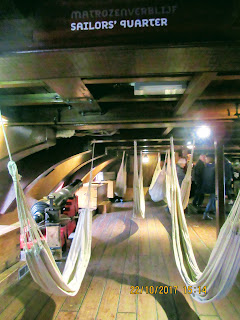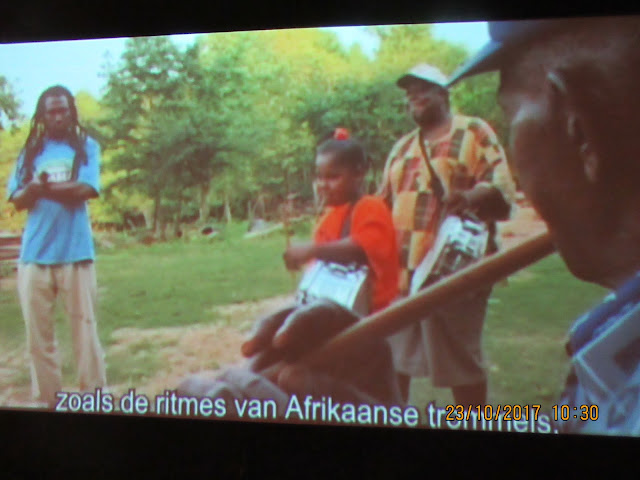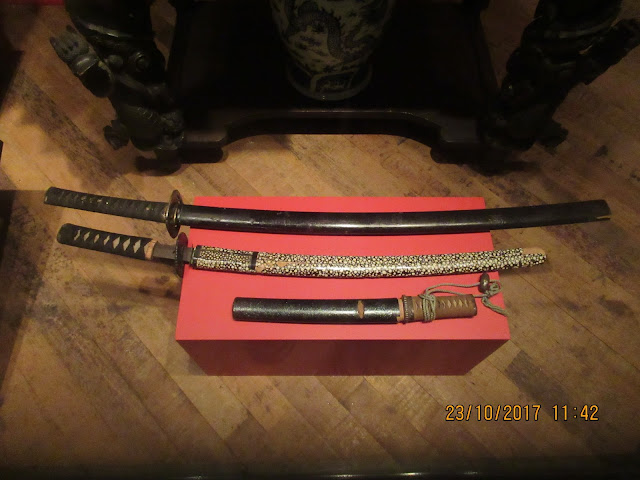Day 1 - five hours at the Maritime Museum. The Dutch have a long maritime history ... from exploring, to warring, to innovation in map-making, navigation and ship-building.
This is the king's boat:
This ship we were able to explore. This may have gone off to exotic lands to bring back spices:
She was capable of defending herself:
The crew's quarters ... ug:
Canons and all the supplies needed to fire them:
Standing on deck, looking up:
The loo:
The Captain & officers ate here:
Ship's wheel:
After a great lunch in the museum cafeteria we walked to the Red Light district to explore this museum:
Day 2 - Tropen Museum and a canal boat tour.
This building is a work of art in itself, both outside and inside:
We spent 5 hours at the Tropen - an ethnographic museum that we thoroughly enjoyed. Today was a school holiday and Tropen museum Junior was bursting with happy kids.
The museum has 8 permanent collections. The special exhibitions we saw were: on Rhythm & Roots about the history of African music and its influence on other genres of music from past to present. Some I had never heard of. One on Body Art and one on slavery as it relates to the Dutch People. The permanent exhibits were from all over the world, but especially Asian countries.
RHYTHM & ROOTS
It was a good time plugging our earphones in while reading the history:
Some instruments from Africa where music is an important part of daily life:
Canada's Matt Anderson was featured in the Blues section:
John Lee Hooker:
One of Jimi Hendrix's guitars:
BODY ART
This included: make-up, painting, branding, tattooing and piercing:
Women from this tribe had their faces tattooed when they were 9 years old:
I love this clay pot:
This big gold piece is what is in this man's ear lobe:
Full body tattoos in the world of the Japanese mafia:
AFRICAN FASHION:
A clear plastic rain jacket with beads sewen on:
Looks like hand-painted fabric:
Especially like the pants:
TORN T-SHIRTS
In the Asmat region of southern New Guinea, there is a whole culture of torn T-shirts. Clothes were very hard to come by and usually gotten through hard labour.
Only the Asmat knows the story behind their precious clothing. Speculations are many and include: was it a successor to former body cuts and slashes that demonstrated courage and gave magical power; or was it a protest against clothing regulations imposed by occupying Indonesian powers, or was it something else altogether?
We took no photos of the Slavery exhibit. There was a lot of listening to stories. Here from the Tropen website is their own description of their exhibit:
The exhibition places the enslaved and their descendants centre stage. To initiate a sometimes difficult but productive dialogue, the Tropenmuseum has sought out personal stories from past and present that bring the history of slavery and its current-day legacies up close. The pieces on display from the Tropenmuseum’s collection – tangible relics of the history of slavery – serve to intensify the experience. Afterlives of Slavery presages the permanent display on the contemporary legacies of slavery and colonialism (2021)."
FROM the PERMANENT COLLECTION
Then we headed out to choose amongst the many canal tours and were pleased with our 'Grey Line' pick. The Captain had a few stories to embellish our audio tour:
All of the buildings have hoists at the top to get furniture and other large items into the upstairs rooms. He tells us with a chuckle that when a Dutchman is too drunk to negotiate the steep, narrow staircase, the hoist is used on him ... thus, the Flying Dutchman!!
He also tells us that 200,000 bicycles are pulled from the bottom of the canals every year! There are 800,000 people in Amsterdam and approximately 1.3 million bicycles.
These are the Dancing Buildings, due to the rot in the wooden beams upon which they are built. New beams today are made of concrete.
The Opera house and Ballet centre:
The beautiful bridge supports:
Here, seven bridges are lined up, but the camera can't capture them all:
Twin sister buildings. Building codes of the day limited the width of buildings, so wealthy people bought 2 lots and built 1 house. Sometimes the facades were the same and sometimes looked completely different:
A great day.
Catching the plane to Vancouver tomorrow...the end to 5 months of travel. Perhaps a final post in a few weeks with reflections.








































































































